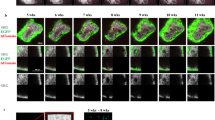Abstract
Aseptic loosening is one of the major reasons for failure of joint prostheses. The periprosthetic tissue has previously been described microscopically; however, little work has been devoted towards quantitating genes expressed by cells at the materials/tissue interface. This study aims to characterize the phenotypic expression of osteoblasts and test the feasibility of quantifying the level of gene expression in periprosthetic tissue sections by combining in situ hybridization and image analysis techniques. There are many factors to consider when quantifying mRNA, in that comparing labeling between different cDNA probes, these should have comparable length and base comparison. The probes should be labeled with the same specific activity, that is the amount of probe to label added is the same, both between different probes and between batches of the same probe. Chromagen color reactions are variable in that the color development is not always linear and more likely follows a sigmoidal curve. Samples should only be compared when it is known that the reaction has been in the linear range. The image analysis of such staining introduces further factors which should be considered and controlled. Color analysis is a very complex problem with respect to reproducibly analyzing histological sections. The brightness component of the image should be independent of the colors within the image, in conventional RGB (red, green and blue) signalling mode this is not possible, while when using HSI (hue saturation and intensity) mode this becomes possible, and factors like staining intensity and brightness of the image become much more accountable and controllable. With these factors identified, we consider that the quantitative image analysis approach does allow comparison of patterns of bone-related mRNAs and demonstrates differences in expression in these osteogenic factors depending on distance from the prosthesis, tissue type, patient and device. © 1998 Kluwer Academic Publishers
Similar content being viewed by others
References
Y. Kadoya, P. A. Revell, N. Al-saffar, A. Kobayashi, G. Scott and M. A. R. Freeman, J. Orthopaed. Res. 14 (1996) 473.
N. Al-saffar, P. A. Revell and A. Kobayashi, J. Mater. Sci. Mater. Med. 8 (1997) 641.
N. Al-saffar, P. A. Revell, H. A. Khwaja and W. Bonfield, ibid. 6 (1995) 762.
W. A. Jiranek, M. Machado, M. Jasty, D. Jevsevar, H. J. Wolfe, S. R. Goldring, M. J. Goldberg and W. H. Harris, Am. J. Bone Joint Surg. 75 (1993) 863.
H. Zreiqat, B. Markovic, W. R. Walsh and C. R. Howlett, J. Biomed. Mater. Res. Appl. Biomater. 33 (1996) 217.
Author information
Authors and Affiliations
Rights and permissions
About this article
Cite this article
Hunt, J.A., Williams, D.F., Howlett, C.R. et al. Quantification of the bone-related mRNAs at the bone/prosthetic interface. Journal of Materials Science: Materials in Medicine 9, 691–694 (1998). https://doi.org/10.1023/A:1008930331180
Issue Date:
DOI: https://doi.org/10.1023/A:1008930331180




